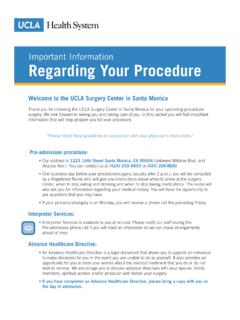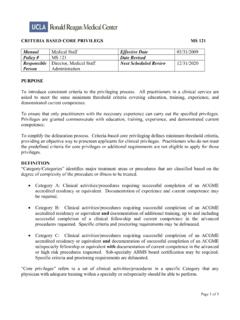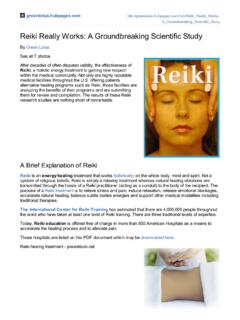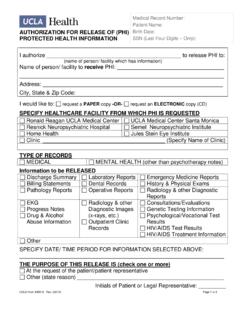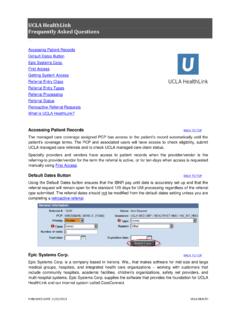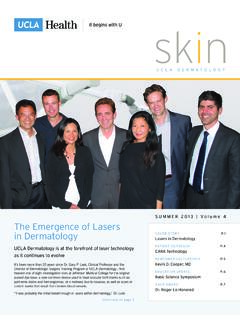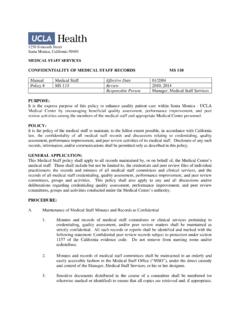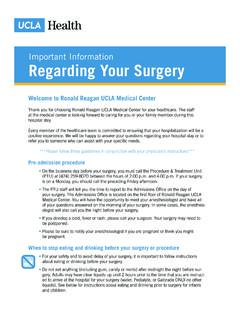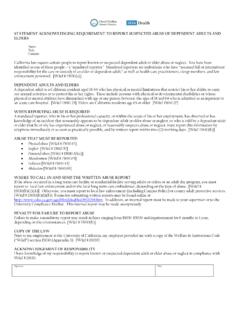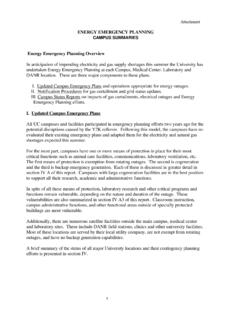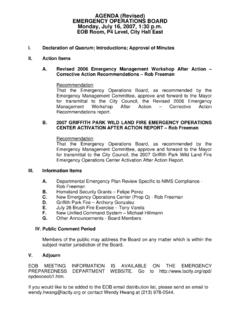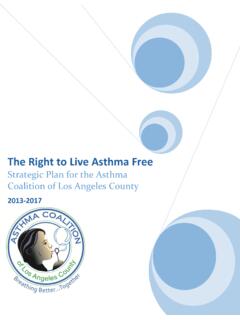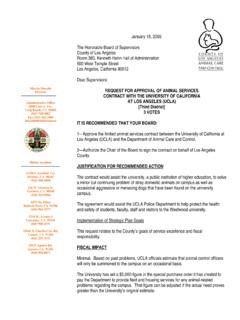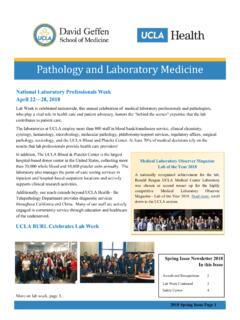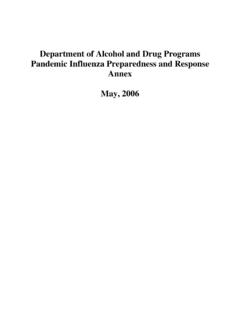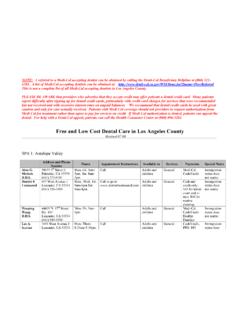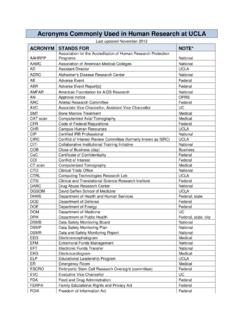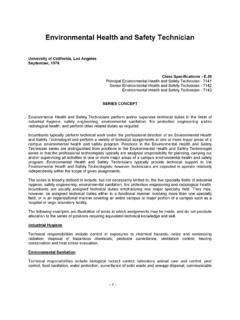Transcription of Biosafety Manual 6-15-2010 - UCLA Health
1 UCLA. Biosafety Manual Table of Contents 1. Laboratory-specific Biosafety Manual Checklist 2. emergency Procedures and Contact Information 3. In-lab Biosafety Training Record 4. Biosafety Cabinet: Information for Certification, Repairs and Maintenance 5. Bloodborne Pathogen Training 6. Biological Safety Cabinet Training 7. Medical Waste Management Training 8. BSL2 Training 9. Standard Operating Procedure (SOP). 10. Bloodborne Pathogen Standard Exposure Control plan 11. Bloodborne Pathogen OSHA Fact Sheet 12. Biosafety Considerations for Research with Lentiviral Vectors 13. UCLA Lab Worker HIV/BBP Exposure Information 14.
2 Lab emergency Information Laboratory-Specific Biosafety Manual Checklist Each laboratory is required to have a lab-specific Biosafety Manual and cannot be borrowed or copied from another lab. At the time of inspection, applicable documents listed below will be reviewed for completion. For questions please contact the Biosafety Program at or 310-206-3929. emergency Contact X. emergency contact information sheet (Template Issued by Biosafety ). Principal Investigator, Lab Supervisor, Biosafety Office . Administrative X. Copy of your most current IBC application and approval letter Include copies of amendment approval letters.
3 Copy of your lab's most recent inspection checklist (Issued by Biosafety ) . Hazards of Agents (Biohazard Specific). Technical Data Sheet or information sheet from the vendor (if available) . A brief description of any possible hazards to lab people if exposed. You can use a MSDS or fact sheet print-out from: Health Canada website: #menu . CDC Diseases & Conditions A-Z index website: . Lentivirus Guidance Document from the NIH (cut & paste the link into your web browser to open the webpage): . Training X. Certificates from Biosafety Training (if missing, email Biosafety Program) . Handouts from Biosafety Training (most current copy).
4 Lab-specific Safety Training Roster (including occupational Health surveillance records). Lab-specific Biosafety training must be given by someone who is experienced in manipulation of the biohazard agent being used. All employees must sign and date a training log showing that . they were trained in the manipulation of biohazard materials. Lab-Specific Procedures X. Standard Operating Procedures: must describe, but not limited to the following, (can use Biosafety template). Personal protective equipment ( , lab coat, gloves, etc). Manipulation, culturing, handling of biohazard materials (lab and/or animal research).
5 Transport of biohazard materials (lab and/or animal research). Decontamination (agent, equipment) and disposal procedure including spill clean-up Procedure to follow if injury or exposure occurs including reporting Agent Summary Sheet ( animal research, if applicable). Required for each agent listed in the Biohazardous Agents section of your ARC protocol . Procedure for the Disposal of Biohazardous Animals (Issued by Biosafety , if applicable) . Occupational Health and Resources X. Exposure Control plan (Template Issued by Biosafety ) . OSHA Bloodborne Pathogen fact sheets Download at.
6 HIV/BBP Exposure Card 2008 (Issued by Biosafety ) . CDC/NIH Regulations Printout relevant sections of CDC/NIH regulations from the BMBL . Download at EH&S Biosafety Program Revised July 2009. emergency Procedures & Contact Information Principal Investigator Name: Phone #: emergency Phone #: Alternate Contact Person Name: Phone #: emergency Phone #: EH&S. 310-825-5689 (Main Office). 310-206-3929 ( Biosafety Main Line). 310-825-3323 ( Biosafety Officer). UCLA Police Dispatch 911 from a campus landline 310-825-1491 from a cell phone Where to go for emergency Care Staff & Graduate Students Occupational Health Facility, 67-120 CHS, x56771.
7 Mon Fri 7:30 am 4:30 pm Undergraduate Students Arthur Ashe Wellness Center (next to the John Wooden Center). Mon Fri 7:30 am 4:30 pm After hours, holidays, weekends, or for major emergencies UCLA emergency Room in the Ronald Reagan Medical Center EH&S Biosafety Program Revised July 2009. In-lab Biosafety Training Record In-lab Biosafety training is required before the start of experiments and at least annually thereafter. Training must be conducted by the PI, lab manager or someone else proficient in Biosafety procedures and techniques that will be used in the lab. For questions contact the Biosafety Program at x63929 or Principal Investigator: Training Conducted by: The laboratory research personnel listed below have received training in the following topics: Example: Read the Biosafety Manual 1.
8 2. 3. 4. 5. Example topics include: Biosafety Manual , emergency procedures, signs and symptoms of exposure, clean-up/decontamination procedures, exposure control plan , etc. Print Name Signature Date Date Hepatitis B. Vaccination Offered EH&S Biosafety Program Revised May 2009. Biosafety Cabinet Certification, Maintenance & Repair Biosafety Cabinets must be certified: Newly purchased Annually Repaired Relocated Technical Safety Services, Inc (TSS) Email Contact Los Angeles Office Gerry Ruiz 562-694-3626 Corporate Office Tim Hassler 800-877-7742 According to the UC system contract, Technical Safety Services (TSS) is the only vendor authorized to service Biosafety cabinets at UCLA.
9 The UCLA EH&S Biosafety Program offers training on the safe use of Biosafety cabinets. The training is required for personnel using, purchasing, working with infectious materials under Biosafety Level 2 or higher (including materials under the Bloodborne Pathogens Standard), working with animals requiring biocontainment housing, or other research related projects involving the use of BSC's (also known as tissue culture hoods). Please visit the EH&S website at and click on Training for more information. For more information, please contact the UCLA Biosafety Program at 310-206-3929 or Bloodborne Pathogen Standard Training UCLA Environment, Health and Safety Biosafety Program Training Objectives Identify the hazards associated with Bloodborne Pathogens Understand local, state and federal regulations Ensure proper handling and disposal Review spill response procedures Quiz Identify the Hazards Biohazard: An agent of biological origin that has the capacity to produce harmful effects on humans.
10 Microorganisms, toxins and allergens derived from those organisms, and allergens and toxins derived from plants or animals. Overview of Disease Caused by Pathogens Microorganisms are classified into 4 main groups: Bacteria Viruses Fungi Parasites Modes of Transmission Air drops of mucus, colds, Fecal oral route: enteric usually flu ( tuberculosis) hand to mouth transmission, contaminated water or food ( salmonella, Hepatitis A). Bloodborne What are Bloodborne Pathogens? Pathogenic microorganisms that are present in in human blood, blood products, and blood components and can cause disease in humans.

